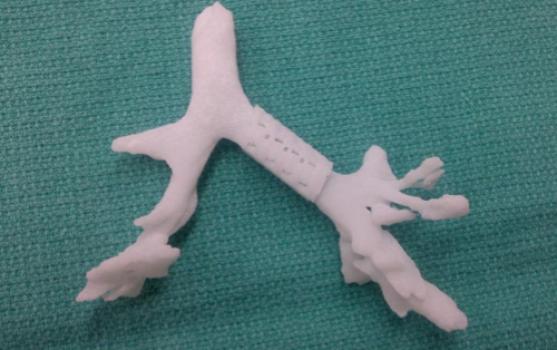Three babies given 3-D printed custom-designed airway splints found healthy in follow-up study
April 29, 2015

Three babies’ lives were saved with this groundbreaking 3-D printed device that restored their breathing (credit: University of Michigan Health System)
Three babies who received groundbreaking 3-D-printed devices that helped keep their airways open are today healthy, off of ventilators, and no longer need paralytics, narcotics and sedation, say researchers have closely followed their cases to see how well the bioresorable splints implanted in all three patients have worked.
The promising results were published in today’s (April 29) issue of Science Translational Medicine.
Kaiba was just a newborn when he turned blue because his little lungs weren’t getting the oxygen they needed. KurzweilAI reported the splint implant procedure in 2013.
Garrett spent the first year of his life in hospital beds tethered to a ventilator, being fed through his veins because his body was too sick to absorb food. Baby Ian’s heart stopped before he was even six months old.
The three babies all had the same life-threatening condition: a terminal form of tracheobronchomalacia, which causes the windpipe to periodically collapse and prevents normal breathing. There was no cure and life-expectancies were grim.
They became the first in the world to benefit from groundbreaking 3-D-printed devices that helped keep their airways open, restored their breathing, and saved their lives.
UM Health System | How 3D printed devices saved three babies’ lives at Mott
Little chance of surviving previously
“Before this procedure, babies with severe tracheobronchomalacia had little chance of surviving,” said senior author Glenn Green, M.D., associate professor of pediatric otolaryngology at C.S. Mott Children’s Hospital. “Today, our first patient Kaiba is an active, healthy 3-year-old in preschool with a bright future.
“The device worked better than we could have ever imagined. We have been able to successfully replicate this procedure and have been watching patients closely to see whether the device is doing what it was intended to do. We found that this treatment continues to prove to be a promising option for children facing this life-threatening condition that has no cure.”
Using 3D printing, Green and his colleague Scott Hollister, Ph.D., professor of biomedical engineering and mechanical engineering and associate professor of surgery at U-M, were able to create and implant customized tracheal splints for each patient. The device was created directly from CT scans of their tracheas, integrating an image-based computer model with laser-based 3D printing to produce the splint.
The specially designed splints were placed in the three patients at C.S. Mott Children’s Hospital. The splint was sewn around their airways to expand the trachea and bronchus and give it a skeleton to aid proper growth. The splint is designed to be reabsorbed by the body over time. The growth of the airways were followed with CT and MRI scans, and the device was shown to open up to allow airway growth for all three patients.
No complications
The findings reported today suggest that early treatment of tracheobronchomalacia may prevent complications of conventional treatment such as a tracheostomy, prolonged hospitalization, mechanical ventilation, cardiac and respiratory arrest, food malabsorption and discomfort. None of the devices, which were implanted in then 3-month-old Kaiba, 5-month-old Ian and 16-month-old Garrett have caused any complications.
The findings also show that the patients were able to come off of ventilators and no longer needed paralytics, narcotics and sedation. Researchers noted improvements in multiple organ systems. Patients were also relieved of immunodeficiency-causing proteins that prevented them from absorbing food, so that they no longer needed intravenous therapy.
Doctors received emergency clearance from the FDA to do the procedures for each child. The authors say the procedure was not designed for device safety and that rare potential complications of the therapy may not yet be evident. However, Richard G. Ohye, M.D., head of pediatric cardiovascular surgery at C.S. Mott, who performed the surgeries, says the cases provide the groundwork to potentially explore a clinical trial that could help other children with less-severe forms of tracheobronchomalacia in the future.
Abstract of Mitigation of tracheobronchomalacia with 3D-printed personalized medical devices in pediatric patients
Three-dimensional (3D) printing offers the potential for rapid customization of medical devices. The advent of 3D-printable biomaterials has created the potential for device control in the fourth dimension: 3D-printed objects that exhibit a designed shape change under tissue growth and resorption conditions over time. Tracheobronchomalacia (TBM) is a condition of excessive collapse of the airways during respiration that can lead to life-threatening cardiopulmonary arrests. We demonstrate the successful application of 3D printing technology to produce a personalized medical device for treatment of TBM, designed to accommodate airway growth while preventing external compression over a predetermined time period before bioresorption. We implanted patient-specific 3D-printed external airway splints in three infants with severe TBM. At the time of publication, these infants no longer exhibited life-threatening airway disease and had demonstrated resolution of both pulmonary and extrapulmonary complications of their TBM. Long-term data show continued growth of the primary airways. This process has broad application for medical manufacturing of patient-specific 3D-printed devices that adjust to tissue growth through designed mechanical and degradation behaviors over time.